Product Images Aripiprazole
View Photos of Packaging, Labels & Appearance
Product Label Images
The following 13 images provide visual information about the product associated with Aripiprazole NDC 66689-735 by Vistapharm, Llc, such as packaging, labeling, and the appearance of the drug itself. This resource could be helpful for medical professionals, pharmacists, and patients seeking to verify medication information and ensure they have the correct product.
Figure 9 - aripiprazole 10
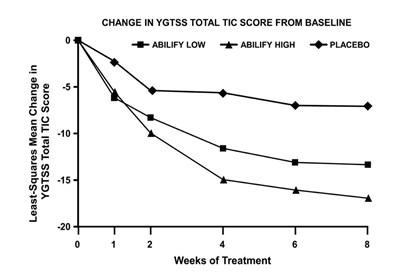
This is a graph showing the change in YGTSS total TIC score from baseline for ABILIFY LOW, ABILIFY HIGH, and PLACEBO. The x-axis represents the weeks of treatment and the y-axis represents the TIC score. The graph shows least-squares mean change over time.*
Aripiprazole Carton - aripiprazole 12
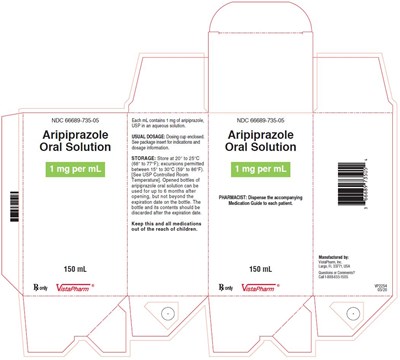
This is a description of Aripiprazole, an oral solution medication with the National Drug Code (NDC) 66689-735-05. Each mL of this medication contains 1 mg of arpiprazole, ISP in an aqueous solution. The usual dosage is indicated in the enclosed package insert. The medication should be stored at 20°C to 25°C (68°F to 77°F) with excursions permitted between 15°C to 30°C (59°F to 86°F). Opened bottles of aripiprazole oral solution can be used for up to 6 months after opening, but not beyond the expiration date on the bottle. The medication is manufactured by a company called VstaPharm. For any comments or questions, patients can call the company's number: 1585855 1505. Pharmacists are advised to dispense the accompanying medication guide to each patient.*
Aripiprazole Bottle Label - aripiprazole 13
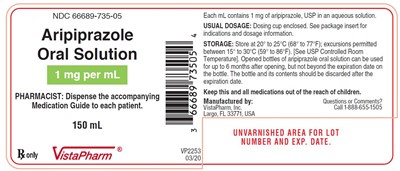
This is a description of Aripiprazole oral solution, containing 1 mg of aripiprazole, used to treat certain mental/mood disorders. A dosing cup is included with the solution, and consumers should see the package insert for recommended dosages. Stored between 20-25°C (68-77°F), opened bottles should be discarded after six months but unopened bottles can be stored until expiration. A medication guide should be provided to each patient, and the product should be kept out of reach of children. Lot number and expiration date are also listed on the bottle.*
FIGURE 1 - aripiprazole 2
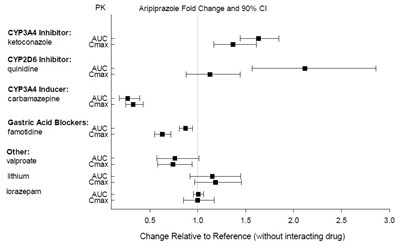
This is a list of drugs and their effect on the metabolism of other drugs. It identifies inhibitors and inducers of CYP3A4 and CYP2D6 enzymes, as well as their effect on the maximal plasma concentration (Cmax) and area under the curve (AUC) of the interacting drug. It also includes the effect of gastric acid blockers and other drugs such as valproate, lithium, and lorazepam on Aripiprazole Fold Change and 90% CI, a measure of the change in the concentration of aripiprazole in the bloodstream.*
figure 2 - aripiprazole 3

This text appears to be a list of various drugs and their effects on certain enzymes and physiological processes in the body. It includes information on the drugs' potential to inhibit or induce specific enzymes, such as CYP3A4 or CYP2D6, and their impact on measures such as AUC and Cmax. It also includes information on the effects of gastric acid blockers, as well as drugs like valproate and lithium. Additionally, the text features a chart showing the "Dehydro-Aripiprazole Fold Change and 90% CI" for an unknown drug.*
figure 3 - aripiprazole 4
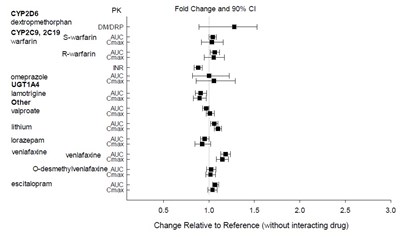
This is a list of drugs and their effects on the activity of an enzyme called CYP2D6. The table contains information on how the drugs may affect the pharmacokinetics of other drugs that are metabolized by CYP2D6. The table also indicates the fold change and confidence interval of the effects of the drugs. It is not clear what the unit of measurement is for the fold change.*
figure 4 - aripiprazole 5
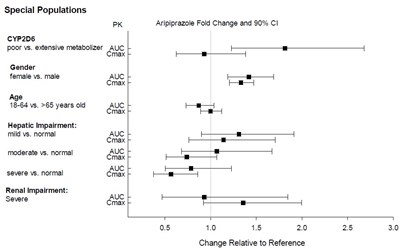
This appears to be a chart outlining different factors that may affect the metabolism and pharmacokinetics of a drug called Aripiprazole in special populations, including those with variations in the CYP2D6 enzyme, gender, age, and hepatic or renal impairment. The chart shows the Fold Change and 90% Confidence Interval of Aripiprazole in these different populations.*
figure 5 - aripiprazole 6

This text likely pertains to a study evaluating pharmacokinetic (PK) variables related to the metabolism and distribution of a drug called Aripiprazole. The study investigates how variables such as age, gender, and hepatic/renal impairment affect the area under the curve (AUC) and peak concentration (Cmax) of the drug in the body. The table shows fold changes and confidence intervals for Dehydro-Aripiprazole, a metabolite of the drug.*
figure 6 - aripiprazole 7
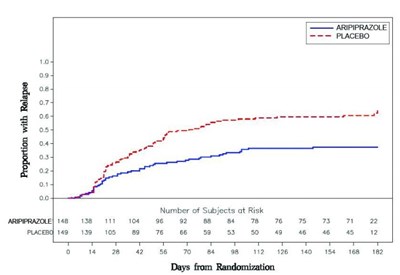
This appears to be a graph showing the proportion with relapse for Aripiprazole and placebo over time. The top shows percentages ranging from 0.01 to 10, while the left column shows the number of subjects at risk over time. Unfortunately, without a clearer image or more context, it is difficult to provide a more detailed description.*
Figure 7 - aripiprazole 8
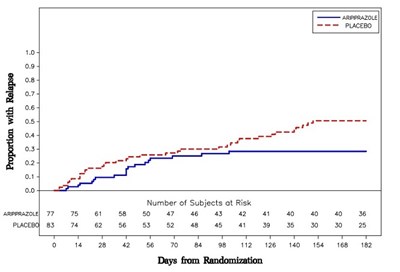
This appears to be a table of clinical data. It shows the proportion of subjects experiencing relapse over time for two groups: one receiving "anpERAZOLE" and the other group receiving "PLACEBO". The table displays the number of subjects at risk for each group at various intervals and the number of days from randomization. It is not possible to determine the condition being treated or any other relevant information from this text.*
figure 8 - aripiprazole 9

This appears to be a chart or graph displaying data related to a study involving a medication called Aripiprazole and a placebo. The chart includes information about the number of subjects involved in the study and the number of days from randomization. However, without additional context it is not possible to provide a more specific description or interpretation of the data.*
* The product label images have been analyzed using a combination of traditional computing and machine learning techniques. It should be noted that the descriptions provided may not be entirely accurate as they are experimental in nature. Use the information in this page at your own discretion and risk.

